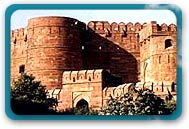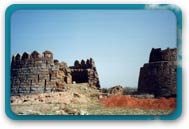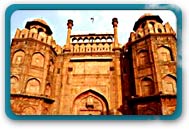|
 |
|
|
|
|
|
|
|
|
|
|
|
|
|
|
|
|
|
| Historical Forts of Delhi |
|
|
| About Delhi |
|
|
 |
|
| Travel Destinations Guide |
|
|
|
|
| Historical Forts - Delhi |
|
| Back |
Since the city of Delhi has served as the capital of many empires, several forts were built over a period of time. However, most of the forts in Delhi were constructed during the rule of the Mughals over the city. These strong citadels were constructed both for the purpose of defense as well as residence. Forts of New Delhi boast of splendid architecture and are aesthetically magnificent. Following is a list of the famous forts in Delhi, the capital of India
 Red Fort or Lal Qila Red Fort or Lal Qila
 The Red Fort or Lal Qila was the part of the city of Shahjahanabad. The fort was started in 1638 AD and completed in 1648 AD by Shahjahan. It is built of red sandstone and has turrets and bastions. The fort is surrounded by a moat in the northeast corner of the city. The wall is two km long and varies in height from 18 m on the riverfront to 33 m in the city. The Red Fort or Lal Qila was the part of the city of Shahjahanabad. The fort was started in 1638 AD and completed in 1648 AD by Shahjahan. It is built of red sandstone and has turrets and bastions. The fort is surrounded by a moat in the northeast corner of the city. The wall is two km long and varies in height from 18 m on the riverfront to 33 m in the city.
The fort contains all the important buildings of Mughal government like the Halls of Public and Private Audience Diwan-I-Aam and Diwan-I-Khas, marble palaces, private apartments, a mosque and elaborately designed gardens. It was attacked by the Persian Emperor Nadir Shah in 1739 AD and by the British soldiers during the war of independence in 1857.
Entrance to the fort is through the imposing Lahore Gate, which takes its name from the fact that it faces Lahore, now in Pakistan. This gate was built by Aurangzeb during his reign and is also known as the Laj Ki Diwar. There is a story that the bazaar of Chandini Chowk was visible from the Diwan-I-Aam. The nobles had to mount down the horse while crossing the bazaar when the emperor was presiding over the hall. Aurangzeb got the wall constructed to make the nobles free from discomfort.
 Old Fort Old Fort
 Old Fort of Delhi is believed to be situated on the same site where the city of Indraprastha once stood. As per the great Indian epic Mahabharta, Indraprastha was the capital city of the Pandavas. Now standing mostly in ruins, the Old Fort of Delhi once served as the seat of administration of a number of glorious emperors. Emperor Sher Shah Suri got the fort constructed after he demolished Humayun's city, Dinpanah. Also known as the Purana Quila, the Old fort is more or less rectangular in shape, with a course of nearly two km. The legend has it that Sher Shah could not complete the construction of Purana Quila during is lifetime. Old Fort of Delhi is believed to be situated on the same site where the city of Indraprastha once stood. As per the great Indian epic Mahabharta, Indraprastha was the capital city of the Pandavas. Now standing mostly in ruins, the Old Fort of Delhi once served as the seat of administration of a number of glorious emperors. Emperor Sher Shah Suri got the fort constructed after he demolished Humayun's city, Dinpanah. Also known as the Purana Quila, the Old fort is more or less rectangular in shape, with a course of nearly two km. The legend has it that Sher Shah could not complete the construction of Purana Quila during is lifetime.
 Tughlaqabad Fort Tughlaqabad Fort
 Tughlaqabad Fort, perched on a rocky hill, constitutes one third of the capital city of India. The fort is located on the Qutab-Badarpur Road and was built by Ghiyas-ud-Din Tughlaq, the founder of the Tughlaq dynasty. The Tuglaqabad Fort seems to be more or less octagonal, with a border of approximately 6.5-km. The ramparts of the fort, now in ruins, are between 10m to 15m high with fortresses and gateways at intervals. The Tughlakhabad at Delhi was built to serve a dual purpose, one of providing a defensive structure to the ruler and the second, to serve as his imposing capital. Tughlaqabad Fort, perched on a rocky hill, constitutes one third of the capital city of India. The fort is located on the Qutab-Badarpur Road and was built by Ghiyas-ud-Din Tughlaq, the founder of the Tughlaq dynasty. The Tuglaqabad Fort seems to be more or less octagonal, with a border of approximately 6.5-km. The ramparts of the fort, now in ruins, are between 10m to 15m high with fortresses and gateways at intervals. The Tughlakhabad at Delhi was built to serve a dual purpose, one of providing a defensive structure to the ruler and the second, to serve as his imposing capital.
  Lal Kot or Qila-I-Rai Pithora Lal Kot or Qila-I-Rai Pithora
Lal Kot was built by the Tomar ruler Anangpal I in about 731 A.D and said to have been rebuilt by Anangpal II in 11th century when he transferred the Capital from Kannauj to Delhi. The Chauhans defeated the Tomars in 12th century AD. Prithviraj extended the old city of Lal Kot and added ramparts and moat. Prithviraj was also known as Rai Pithora and thus it came to be known as Qila-I-Rai Pithora, the first city of Delhi. Lal Kot was an oblong structure having seven gates-Sohna, Ranjit, Ghazni, Hauz Rani, Barka, Budaun and Maya. Only ramparts are visible near the Qutub Minar although it is said to have had several Jain and Hindu temples. Mohammad Ghori invaded India towards the end of the 12th century AD from Afghanistan and defeated Prithviraj and occupied Delhi. He, however, returned to Afghanistan after leaving his new kingdom in the hands of his slave Qutub-ud-din Aibak. The Lal Kot continued to be the capital till 1303 AD. |
| Back |
|
|
|
|
|
|
|
|
|
|
|
|
|
